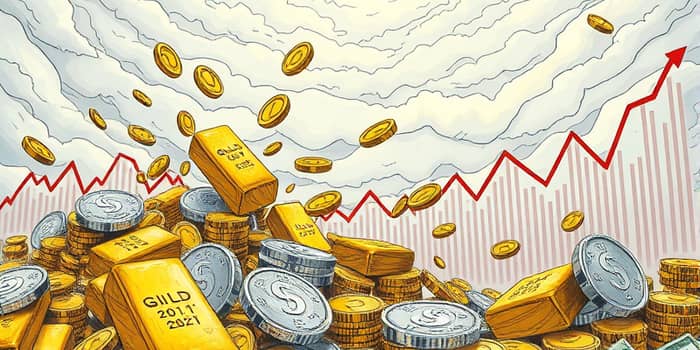
In a world marked by sudden market swings and unpredictable policy shifts, governments and investors alike are revisiting the idea of money tied to tangible assets. Commodity-backed currencies, long considered a relic of economic history, are experiencing a revival as a potential remedy for modern financial uncertainty. This article explores the roots, benefits, and challenges of returning to a system where currency value is anchored to physical commodities.
Commodity-backed currencies are forms of money directly tied to the value of physical assets, most commonly gold and silver. Historically, these systems provided a clear mechanism for limiting inflation because the money supply was constrained by reserves. Under the classic gold standard, each country agreed to convert paper notes into a fixed amount of gold, imbuing them with intrinsic and transparent value for holders.
Beyond gold, other commodities such as copper or oil have occasionally been proposed as backing assets, reflecting the commodity’s local importance or abundance. However, gold’s stability and universal acceptance made it the prime candidate for centuries of use in global finance.
From ancient Mesopotamia’s barley and silver exchanges to medieval Europe’s gold coins, commodity money has deep roots. The formal gold standard, which took hold in the 19th century, created an era of relative price stability and predictable exchange rates. Central banks held reserves of bullion, ensuring that every banknote in circulation was matched by a secure asset.
This evolution taught policymakers that while commodity backing can anchor confidence, it also exposes national economies to shifts in commodity markets that lie outside monetary control.
Recent years have been defined by major shocks that triggered a wave of economic uncertainty. The COVID-19 pandemic, the war in Ukraine, and the global energy transition each disrupted commodity markets and challenged fiat systems’ ability to maintain long-term purchasing power for consumers.
Emerging market economies felt these swings most acutely, with fiscal balances and currency values buffeted by rapid price changes. The volatility raised questions about the resilience of standard monetary policy tools when confronted with exogenous shocks.
Amid persistent inflation and eroding trust in fiat anchors, commodity-backed proposals have reemerged. Advocates argue that a tangible reserve base would impose discipline on money creation by central banks and act as a shield against the devaluation that accompanies expansive monetary policy.
Public discourse in 2024 and 2025 saw opinion pieces and policy forums debating gold-backed digital currencies and partial reserves for standard notes. Some investment funds began to accumulate bullion and other strategic minerals as a direct response to fears of currency debasement.
The table highlights a core trade-off: stability through an asset anchor versus flexibility in responding to financial shocks. Commodity prices can be volatile too, and a sudden downturn in resource value could spell trouble for a rigidly backed currency.
Logistical challenges also arise. Storing and auditing large reserves of physical materials adds cost and complexity. A transition back to such a system would require extensive coordination, new legal frameworks, and significant up-front investments.
Central banks in emerging markets have ramped up foreign exchange interventions to cushion their currencies. According to a recent BIS survey, 80% of these banks view limiting speculative pressure as a top priority. Some nations are also building robust sovereign wealth funds from commodity windfalls, channeling excess revenues into diversified assets to buffer future downturns.
Meanwhile, advanced economies weigh the desire for fiscal discipline against the need for proactive monetary tools. A commodity link could restore trust but at the cost of reducing the velocity and scale of stimulus available during recessions.
Economists note that while strict commodity backing may be impractical in today’s complex financial environment, hybrid models are gaining currency. These include partial backing, dynamic basket pegs, or digital currencies tied to a mix of commodities and government bonds.
“Policymakers should use upswings in commodity prices to prepare for the next downturn,” advises a recent report. Such preparations involve not only reserve accumulation but also the development of adaptive policy frameworks capable of managing shocks without undermining stability.
Resource-rich countries like Canada, Australia, and Russia have currencies that inherently track certain commodity indices. Although these are fiat systems, they demonstrate the natural correlation between commodity export earnings and currency strength. In countries such as Chile and Norway, sovereign wealth funds funded by oil revenue provide a model for converting commodity wealth into diversified financial reserves.
These examples illustrate how governments can draw lessons from historical commodity money without fully reinstating a gold standard. By combining financial innovation with prudent fiscal policy, they aim to harness the benefits of tangible assets while retaining strategic monetary flexibility.
New technologies are reshaping how commodity backing could work. Blockchain platforms enable tokenizing physical assets, creating digital gold certificates that can be traded instantly. This innovation promises transparent auditing and instant settlement while reducing storage and logistical costs. Smart contracts could enforce automatic reserve ratios, ensuring that each digital unit is backed by actual commodity held in audited vaults.
However, governance of such systems remains a challenge. Establishing trusted custodians, setting global audit standards, and ensuring cybersecurity are critical concerns. Hybrid models that blend traditional central bank oversight with decentralized ledger technology may offer the best of both worlds, combining institutional trust with modern efficiency.
As global markets endure further uncertainty, the debate over commodity-backed currencies offers a powerful reminder of the need for credibility in money. While a strict asset-peg may not be universally viable, the principles of transparency, discipline, and long-term stability remain essential goals.
Innovation in digital currencies, hybrid reserve systems, and strengthened fiscal institutions could bridge the gap between the past and the future of money. By learning from history and leveraging modern financial tools, policymakers have the opportunity to craft a monetary framework that provides both confidence and resilience in an unpredictable world.
References













